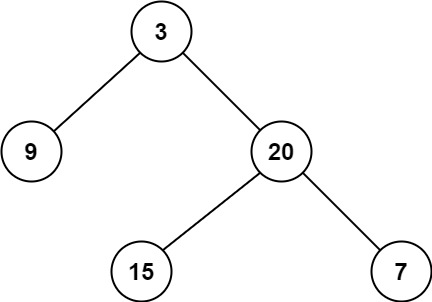原文链接: https://leetcode-cn.com/problems/minimum-depth-of-binary-tree
英文原文
Given a binary tree, find its minimum depth.
The minimum depth is the number of nodes along the shortest path from the root node down to the nearest leaf node.
Note: A leaf is a node with no children.
Example 1:

Input: root = [3,9,20,null,null,15,7] Output: 2
Example 2:
Input: root = [2,null,3,null,4,null,5,null,6] Output: 5
Constraints:
- The number of nodes in the tree is in the range
[0, 105]. -1000 <= Node.val <= 1000
中文题目
给定一个二叉树,找出其最小深度。
最小深度是从根节点到最近叶子节点的最短路径上的节点数量。
说明:叶子节点是指没有子节点的节点。
示例 1:

输入:root = [3,9,20,null,null,15,7] 输出:2
示例 2:
输入:root = [2,null,3,null,4,null,5,null,6] 输出:5
提示:
- 树中节点数的范围在
[0, 105]内 -1000 <= Node.val <= 1000
通过代码
高赞题解
思路:
很多人写出的代码都不符合 1,2 这个测试用例,是因为没搞清楚题意
题目中说明:叶子节点是指没有子节点的节点,这句话的意思是 1 不是叶子节点
题目问的是到叶子节点的最短距离,所以所有返回结果为 1 当然不是这个结果
另外这道题的关键是搞清楚递归结束条件
叶子节点的定义是左孩子和右孩子都为 null 时叫做叶子节点
当 root 节点左右孩子都为空时,返回 1
当 root 节点左右孩子有一个为空时,返回不为空的孩子节点的深度
当 root 节点左右孩子都不为空时,返回左右孩子较小深度的节点值
第一版代码:
class Solution {
public int minDepth(TreeNode root) {
if(root == null) return 0;
//这道题递归条件里分为三种情况
//1.左孩子和有孩子都为空的情况,说明到达了叶子节点,直接返回1即可
if(root.left == null && root.right == null) return 1;
//2.如果左孩子和由孩子其中一个为空,那么需要返回比较大的那个孩子的深度
int m1 = minDepth(root.left);
int m2 = minDepth(root.right);
//这里其中一个节点为空,说明m1和m2有一个必然为0,所以可以返回m1 + m2 + 1;
if(root.left == null || root.right == null) return m1 + m2 + 1;
//3.最后一种情况,也就是左右孩子都不为空,返回最小深度+1即可
return Math.min(m1,m2) + 1;
}
}
代码可以进行简化,当左右孩子为空时 $m1$ 和 $m2$ 都为 $0$
可以和情况 $2$ 进行合并,即返回 $m1+m2+1$
简化后代码如下:
class Solution {
public int minDepth(TreeNode root) {
if(root == null) return 0;
int m1 = minDepth(root.left);
int m2 = minDepth(root.right);
//1.如果左孩子和右孩子有为空的情况,直接返回m1+m2+1
//2.如果都不为空,返回较小深度+1
return root.left == null || root.right == null ? m1 + m2 + 1 : Math.min(m1,m2) + 1;
}
}
统计信息
| 通过次数 | 提交次数 | AC比率 |
|---|---|---|
| 296062 | 604861 | 48.9% |
提交历史
| 提交时间 | 提交结果 | 执行时间 | 内存消耗 | 语言 |
|---|
相似题目
| 题目 | 难度 |
|---|---|
| 二叉树的层序遍历 | 中等 |
| 二叉树的最大深度 | 简单 |




